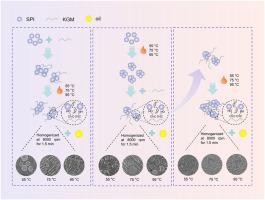Influence of different heat treatments on the emulsifying properties of the composite of soy protein isolate and konjac glucomannan
IF 11
1区 农林科学
Q1 CHEMISTRY, APPLIED
引用次数: 0
Abstract
The functional properties of soy protein isolate (SPI) are obvious influenced by heat treatment. To study the combined effects of heat treatment and konjac glucomannan (KGM) on SPI properties, we selected three critical temperatures (55 °C, 75 °C, and 95 °C) based on the denaturation thresholds of 7S (β-conglycinin) and 11S (glycinin) globulins. The effects of the three temperatures and three heat treatments (pre-heating, post-heating, and secondary heating) on the structure and function of SPI were subsequently investigated. The results indicated that pre-heating improved SPI foaming performance, particularly at 75 °C, where foaming capacity reached 70.67 %. Post-heating and secondary heating significantly enhanced emulsification performance compared to the untreated SPI-KGM complex at 75 °C, with the emulsifying activity and stability indices reaching about 1.7 and 1.15 times those of SG, respectively. This study provides a theoretical basis for designing SPI-based foods with various functional properties through specific heat treatments.

不同热处理工艺对大豆分离蛋白与魔芋葡甘露聚糖复合材料乳化性能的影响
大豆分离蛋白(SPI)的功能特性受热处理的影响较大。为了研究热处理和魔芋葡甘露聚糖(KGM)对SPI性能的联合影响,我们根据7S (β-甘氨酸)和11S(甘氨酸)球蛋白的变性阈值选择了3个临界温度(55℃、75℃和95℃)。随后研究了三种温度和三种热处理(预热、后加热和二次加热)对SPI结构和功能的影响。结果表明,预热提高了SPI的发泡性能,特别是在75℃时,发泡率达到70.67%。与未处理的SPI-KGM配合物相比,75℃后加热和二次加热显著提高了其乳化性能,乳化活性和稳定性指标分别达到SG的1.7倍和1.15倍左右。本研究为通过特殊热处理设计具有不同功能特性的spi食品提供了理论依据。
本文章由计算机程序翻译,如有差异,请以英文原文为准。
求助全文
约1分钟内获得全文
求助全文
来源期刊

Food Hydrocolloids
工程技术-食品科技
CiteScore
19.90
自引率
14.00%
发文量
871
审稿时长
37 days
期刊介绍:
Food Hydrocolloids publishes original and innovative research focused on the characterization, functional properties, and applications of hydrocolloid materials used in food products. These hydrocolloids, defined as polysaccharides and proteins of commercial importance, are added to control aspects such as texture, stability, rheology, and sensory properties. The research's primary emphasis should be on the hydrocolloids themselves, with thorough descriptions of their source, nature, and physicochemical characteristics. Manuscripts are expected to clearly outline specific aims and objectives, include a fundamental discussion of research findings at the molecular level, and address the significance of the results. Studies on hydrocolloids in complex formulations should concentrate on their overall properties and mechanisms of action, while simple formulation development studies may not be considered for publication.
The main areas of interest are:
-Chemical and physicochemical characterisation
Thermal properties including glass transitions and conformational changes-
Rheological properties including viscosity, viscoelastic properties and gelation behaviour-
The influence on organoleptic properties-
Interfacial properties including stabilisation of dispersions, emulsions and foams-
Film forming properties with application to edible films and active packaging-
Encapsulation and controlled release of active compounds-
The influence on health including their role as dietary fibre-
Manipulation of hydrocolloid structure and functionality through chemical, biochemical and physical processes-
New hydrocolloids and hydrocolloid sources of commercial potential.
The Journal also publishes Review articles that provide an overview of the latest developments in topics of specific interest to researchers in this field of activity.
 求助内容:
求助内容: 应助结果提醒方式:
应助结果提醒方式:


